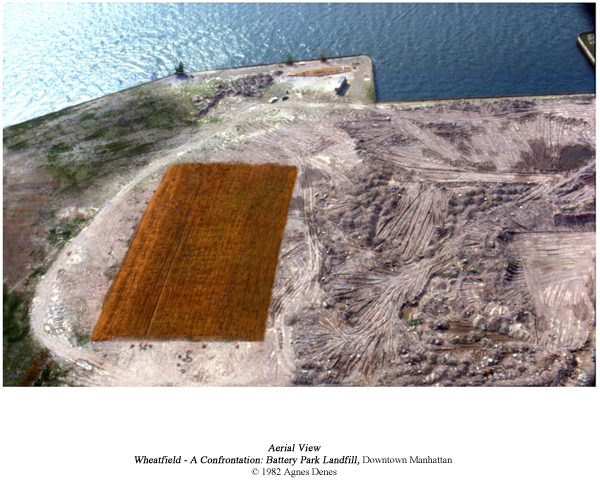Agnes Denes is one of the featured artists in the current exhibit Expo1 taking place at PS1 through September 2nd. Denes is an environmental artist. Her canvas is literally the world around us. The work on display at PS1 was documentation (photos) of a piece she created in 1982; Wheatfield – A confrontation: Battery Park Landfill, Downtown Manhattan. It is a powerful work of art! It is a work that calls for change as it exemplifies beauty, calls for hope, and explores the human condition.
From an aesthetic standpoint, the photographs probably do not do the piece justice, but what they show is nothing short of breathtaking. Remember the context is 1982. The Battery is not a lush green environment; it is barren. Also recall that 9/11 is unimaginable. A wispy rural wheat field, two acres of wheat growing in a near desolate environment. Golden rods of grain flitting in front of skyscrapers. The image that resonates for me is the amber grain waving in front of the Twin Towers, “America the Beautiful” to a T. The aesthetics of the piece left a tingling sensation in the body.
Webster defines hope as “desire with expectation of obtainment.” When Denes was inspired to do her work, the Battery was a desolate canvas. Two hundred truckloads of dirt were trucked in for the installation. She toiled with the soil for months to ensure that the plain was fertile. In the end, a bountiful crop displayed the amazing opportunity. An empty landscape can be so much more than blight. The opportunities with creativity and hard-work cannot be contained.
Two acres is not a lot of grain in the grand scheme of things. It does not feed many people, and it does not generate a lot of revenue, particularly considering the resources invested into the production. But Wheatfields explores something far more meaningful. According to Denes,
Planting and harvesting a field of wheat on land worth $4.5 billion created a powerful paradox. Wheatfield was a symbol, a universal concept; it represented food, energy, commerce, world trade, and economics. It referred to mismanagement, waste, world hunger and ecological concerns. It called attention to our misplaced priorities.
The field was more than just the beautiful landscape it created. It was even more than just the fruits of someone’s labor. It was a statement to one of the most powerful streets on the planet.
Things have changed in the 30 years since the field. Battery Park is a lush tourist destination containing many new symbols of hope. The Towers have fallen. Some things have not changed, hunger still exists and Wall Street excess still persists. I think there is room for many more installations to make bold proclamations like Denes’ two acres of wheat. There is still room to show us beautiful things in everyday surroundings. There is still a place to show opportunity. There is still a place to show us what really matters in life.
IMAGE CREDIT. [Agnes Denes, “Wheatfield — A Confrontation” (1982), two acres of wheat planted and harvested in Battery Park landfill, Manhattan, New York (© Agnes Denes, via theecologist.org)].




